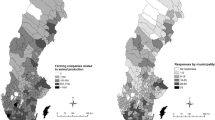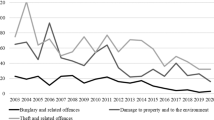Abstract
In this paper we analyse how risk factors in highly industrialised agriculture are connected to animal neglect. With Danish agriculture as a case study, we use two types of data. First, we use register data from Statistics Denmark to map how risk factors such as farmers’ financial and social troubles are connected to convictions of neglect. Second, we analyse narratives where interviewed farmers, involved in cases of neglect, describe how they themselves experienced the incidents. We find that while livestock farmers in general have a low risk of animal neglect problems, a small percentage of them face severe financial difficulties, divorce and psychiatric problems, which are connected to an increased risk of being convicted for the neglect of farm animals. The narratives bring forward themes of pressure related to financial trouble, technological break down, family problems, stress and a growing concern among the farmers towards the governmental control in farm animal production. We discuss how these factors can be used to identify and help farmers with a high risk of being convicted of livestock neglect.




Similar content being viewed by others
Notes
“Farmer given lifetime ban for animal cruelty”, Farmers Weekly, Great Britain, August 2010
“30 dages betinget fængsel for vanrøgt”,Danish Newspaper website, epn.dk, June 2011
“500 varkens maanedlang dood in stal”, National TV News, Netherlands, June 2010.
References
Aadahl, S. (2007). Good lives, hidden miseries, an ethnography of uncertainty in a Finnish village, Research Reports no. 250. Department of Sociology, Helsinki University.
Andrade, S. B. (2012). Levekår i dansk landbrug [Living Conditions in Danish Agriculture]. SFI Report Series 12: 29. Copenhagen: National Centre for Social Research.
Anneberg, I., Vaarst, M., & Sørensen, J. T. (2012). The experience of animal welfare inspections as perceived by Danish livestock farmers: A qualitative research approach. Livestock Science, 147(1–3), 49–58.
Becker, G. (1994). Metaphors in disrupted lives: Infertility and cultural constructions of continuity. Medical Anthropology Quarterly, 8(4), 383–410.
Becker, G. (1997). Disrupted lives—how people create meaning in a chaotic world. Berkeley and Los Angeles, CA: University of California Press.
Boogaard, B. K., Boekhorst, L. J. S., Oosting, S. J., & Sørensen, J. T. (2011). Socio-cultural sustainability of pig production: Citizen perceptions in the Netherlands and Denmark. Livestock Science, 140(1–3), 189–200.
Cloke, P., & Goodwin, M. (1992). Conceptualising countryside change: From post-Fordism to rural structured coherence. Transactions of the Institute of British Geographers, 17, 321–336.
Conger, R., & Elder, G. H. (1994). Families in troubled times: Adapting to change in rural America. New York: A. de Gruyter.
Coyne, J. C., & Downey, G. (1991). Social factors and psychopathology: Stress, social support, and coping processes. Annual Review of Psychology, 42, 401–425.
Danish Agriculture & Food Council (2008). Agriculture in Denmark: Facts and figures 2008. Varde, Denmark: Danish Agriculture and Danish Agricultural Council.
Elder, G. H., & Conger, R. (2000). Children of the land: adversity and success in rural America. Chicago: University of Chicago Press.
Eurostat (2005). Farm structure. Historical results. Surveys from 1966/67 to 1997. Luxemburg: Office for Official Publications of the European Communities.
Facchini, F., & Berton, R. M. (2012). Bachelor farmers in France: An explanation by evolutionary psychology. Applied Behavioural Economics, 1(2), 26–41.
Flynn, A. C., Marsden, T. K., & Smith, E. (2003). Food regulation and retailing in a new institutional context. The Political Quarterly, 74(1), 38–46.
Forsberg, E. M. (2011). Inspiring respect for animals through the law? Current development in the Norwegian Animal Welfare Legislation. Journal of Agricultural and Environmental Ethics, 24, 351–366.
Fraser, D. (2008). Understanding animal welfare: The science in its cultural context. West Sussex: Wiley-Blackwell.
Fraser, C. E., Smith, K. B., Judd, F., Humphreys, J. S., Fragar, L. J., & Henderson, A. (2005). Farming and mental health problems and mental illness. International Journal of Social Psychiatry, 51, 340–349.
Gunderson, P., Donner, D., Nashold, R., Salkowicz, L., Sperry, S., & Wittman, B. (1993). The epidemiology of suicide among farm residents or workers in 5 north-central states, 1980–1988. American Journal of Preventive Medicine, 9(3), 26–32.
Hammersley, M., & Atkinson, P. (2007). Ethnography: Principles in practice. New York: Routledge.
Harfeld, J. (2010). The question of the farm animal: Welfare, ethics, and public policy in modern animal agriculture. Aarhus: Faculty of Theology, Aarhus University.
Hemsworth, P. H., & Coleman, G. J. (2010). Human-livestock interactions: The stockperson and the productivity and welfare of intensively farmed animals. Wallingford, UK: CABI.
Hendrickson, M. K., Heffernan, W. D., Howard, P. H., & Heffernan, J. B. (2001). Consolidation in food retailing and dairy. British Food Journal, 3(10), 715–728.
Hendrickson, M. K., & James, J. S. (2005). The ethics of constrained choice: How the industrialization of agriculture impact farming and farmer behaviour. Journal of Agricultural and Environmental Ethics, 18(3), 269–291.
Hinrichs, C. C., & Welsh, R. (2003). The effects of the industrialization of US livestock agriculture on promoting sustainable production practices. Agriculture and Human Values, 20(2), 125–141.
James, H. S, Jr. (2005). The ethical challenges in farming: A report on conversations with Missouri corn and soybean producers. Journal of Agricultural Safety and Health, 11, 239–248.
Jarvinen, M. (2000). The biographical illusion: Constructing meaning in qualitative interviews. Qualitative Inquiry, 6(3), 370–391.
Jarvinen, M. (2004). Life histories and the perspective of the present. Narrative Inquiry, 14(1), 45–68.
Jenkins, R., & Kovess, V. (2002). Evaluation of suicide prevention: A European approach. International Review of Psychiatry, 14(1), 34–41.
Knorr, B. (1991) ‘Ethics: The American Farmer. Farm Futures. January 10–13.
Krystallis, A., de Barcellos, M. D., Kügler, J. O., Verbeke, W., & Grunert, K. G. (2009). Attitudes of European citizens towards pig production systems. Livestock Science, 126(1–3), 46–56.
Lensink, B. J., Veissier, I., & Florand, L. (2001). The farmer’s influence on calves’ behaviour, health and production of a veal unit. Animal Science, 72(1), 105–117.
Linzer, D. A., & Lewis, J. B. (2011). poLCA: An R package for polytomous variable latent class analysis. Journal of Statistical Software, 42(2), 1–29.
Malmberg, A., Hawton, K., & Simkin, S. (1997). A study of suicide in farmers in England and Wales. Journal of Psychosomatic Research, 43(1), 107–111.
Mutersbaugh, T. (2005). Just-in-space: Certified rural products, labor of quality, and regulatory spaces. Journal of Rural Studies, 21(4), 389–402.
Ochs, E., & Capps, L. (1996). Narrating the self. Annual Review of Anthropology, 25(1), 19–43.
Phillips, C. (2009). The welfare of animals. Animal Welfare, 8, 55–77.
Pig Research Centre. (2011). Interpig 2009—resultater og international konkurrenceevne. Notat nr. 1102.
Raftery, A. E. (1993). Bayesian model selection in structural equation models. In K. A. Bollen & L. S. Long (Eds.), Testing structural equation models (pp. 163–180). Beverly Hills: Sage Publications.
Rappaport, A., & Himschoot, R. A. (1994). Ethics perceptions of American farmers: An empirical analysis. Journal of Business Ethics, 13(10), 795–802.
Rasmussen, K., Carstensen, O., Lauritsen, J. M., Glasscock, D. J., Hansen, O. N., & Jensen, U. F. (2003). Prevention of farm injuries in Denmark. Scandinavian Journal of Work, Environment & Health, 29(4), 288–296.
Reisner, A. (1992). An activist press: The farm press’s coverage of the animal rights movement. Agriculture and Human Values, 9(2), 38–53.
Rollin, B. E. (2003). Farm animal welfare: Social, bioethical, and research issues. Iowa: Iowa State University Press.
Sandoe, P., & Christiansen, S. (2010). Ethics of animal use. Oxford: Blackwell.
Shanin, T. (1971). Peasants and peasant societies: selected readings. Harmondsworth, UK: Penguin.
Statistics Denmark. (2010). Landbrug 2010. Statistik om landbrug, gartneri og skovbrug. Copenhagen.
Steffen, V. (1997). Life stories and shared experience. Social Science and Medicine, 45(1), 99–111.
Stuart, D. (2009). Constrained choice and ethical dilemmas in land management: Environmental quality and food safety in california agriculture. Journal of Agricultural and Environmental Ethics, 22(1), 53–71.
Thompson, P. B. (1998). Agricultural ethics: Research, teaching, and public policy. Iowa: Iowa State University Press.
Tiplady, C. M., Deborah-Anne, B. W., & Phillips, C. J. C. (2012). Public response to media coverage of animal cruelty. Journal of Agricultural and Environmental Ethics. doi:10.1007/s10806-012-9412-0.
Verbeke, W. A. J., & Viaene, J. (2000). Ethical challanges for livestock production: Meeting consumer concerns about meat safety and animal welfare. Journal of Agricultural and Enviromental Ethics, 12(2), 141–151.
Acknowledgments
The authors wish to thank the participating farmers for telling their stories. We also wish to thank the two anonymous reviewers, senior scientist Mette Vaarst, Aarhus University and professor Margaretha Järvinen, University of Copenhagen and The Danish National Centre for Social Research for their valuable comments and suggestions for improving the article. Also thanks to Giddi Smolders and Sylvia Travers for help in identifying cases of neglect in the Netherlands and in England.
Author information
Authors and Affiliations
Corresponding author
Rights and permissions
About this article
Cite this article
Andrade, S.B., Anneberg, I. Farmers Under Pressure. Analysis of the Social Conditions of Cases of Animal Neglect. J Agric Environ Ethics 27, 103–126 (2014). https://doi.org/10.1007/s10806-013-9456-9
Accepted:
Published:
Issue Date:
DOI: https://doi.org/10.1007/s10806-013-9456-9




